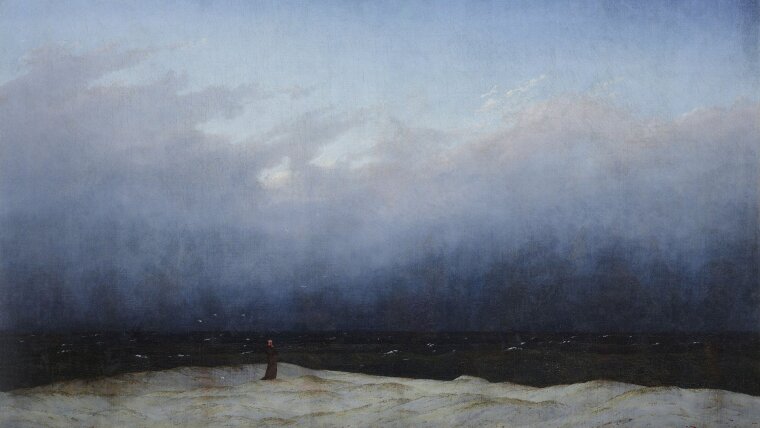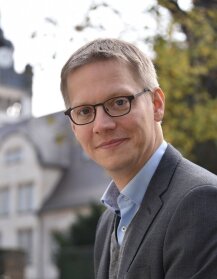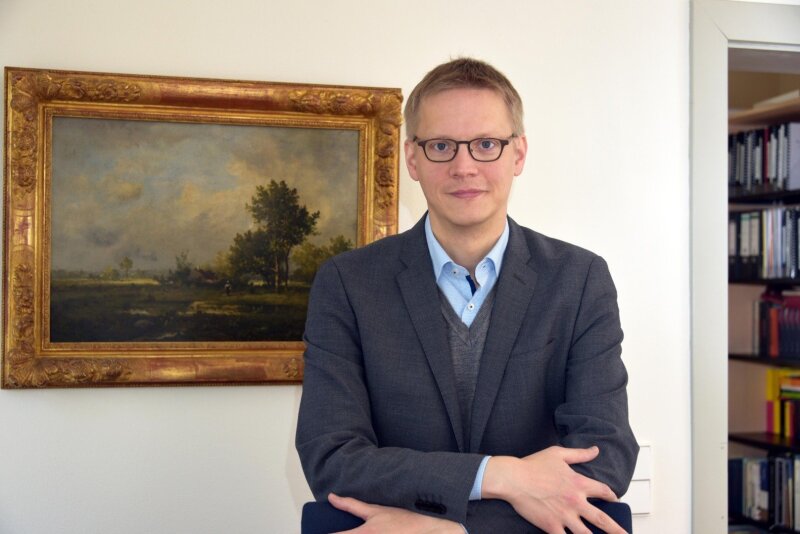
- Knowledge Transfer and Innovation
Published: | By: Sebastian Hollstein
Caspar David Friedrich (1774-1840) Self-portrait with leaning arm, around 1802, pen and brown ink over pencil, Hamburger Kunsthalle, Kupferstichkabinett
Image: © Hamburger Kunsthalle / bpk Foto: Christoph IrrgangSeptember 2024 will mark the 250th anniversary of Caspar David Friedrich's birth. Therefore, the painter and his work are at the centre of a series of events. To kick off the grand jubilee year, the Hamburger Kunsthalle will present the exhibition "Caspar David Friedrich. Art for a New Age"External link, which opens on December 15, 2023. The Friedrich Schiller University's Research Centre for European Romanticism is a cooperation partner of the exhibition. One of its directors, Prof. Dr Johannes Grave, significantly contributes as an external curator to the exhibition's conception.
The Hamburger Kunsthalle presents an extensive exhibition featuring over 60 paintings and around 100 drawings by Friedrich, including popular masterpieces such as "Wanderer above the Sea of Fog," "Chalk Cliffs on Rügen," "The Sea of Ice," and "The Monk by the Sea" (pictured above). The exhibition curators thus offer a retrospective of the artist, inviting once more an unbiased engagement with his work, possibly prompting a re-evaluation of established practices in approaching painting and art.
"Visitors, in observing these works, have the chance for unexpected insights—if they depart from the well-trodden paths on which we view and comprehend images and allow themselves to be guided by Caspar David Friedrich," says Johannes Grave, who has been studying the painter, born in Greifswald in 1774, for over 20 years.
"Unfortunately, there is a widespread tendency when studying Friedrich to decipher his paintings like a riddle and extract preconceived knowledge from them." According to the Jena expert, Friedrich’s landscapes, instead, invite us to immerse into them without pursuing a specific, supposed meaning. "They provide perfect material for contemplation, for independent thought. I suspect that Friedrich intended to evoke in viewers an experience of their own insight, which emerges only in the temporal process of seeing. These paintings offer primarily questions, not answers." Caspar David Friedrich also undermines the promise of concreteness in his paintings, for example, when he does not paint real existing landscapes, but creates them from his imagination, by combining set pieces from reality in a new way.
Questioning the current relationship between humanity and nature
The exhibition team aims to utilize this unbiased approach to art to address current societal issues. The strong reference to nature in Caspar David Friedrich's paintings opens up a second dimension linking the work of the artist, who died in 1840, to the present. "They can be seen as an invitation to challenge a certain predetermined understanding of nature—especially in the Anthropocene, in times of climate change and profound ecological crises," says Johannes Grave.
He currently sees two idealized approaches to tackling these problems: either yearning to return to a kind of untouched paradise of nature or viewing subject and nature in an opposing relationship, where humans control nature and want to master climate change through technical solutions. "We need to realize that the climate crisis is a crisis of our relationship with nature; we need to question preconceptions that have become all too familiar," states the art historian of the University of Jena. "I hope our exhibition can help to initiate such reflections and that visitors will first open themselves to a range of questions before hastily seeking answers."
These impulses not only inspire visitors but also the curator and art historian in his work. Revisiting the work for practical reasons within the context of an exhibition is always enriching. "When selecting works for an exhibition like this, we must always consider how certain paintings, drawings, or graphics fit into our research question, but also into the exhibition space, thereby shedding light on artworks that might have received less attention elsewhere. This is also crucial for my ongoing research," says Johannes Grave, who is currently collaborating with colleagues from Jena and Dresden on an edition of Caspar David Friedrich's writings.
Art historian Prof. Dr Johannes Grave is external curator of the exhibition at the Hamburger Kunsthalle.
Image: Anne Günther (University of Jena)More information about the exhibition: https://www.hamburger-kunsthalle.de/en/exhibitions/caspar-david-friedrich-0External link
Forschungsstelle Europäische Romantik der Universität Jena: https://www.kuk.uni-jena.de/forschungsstelle-europaeische-romantikExternal link (German only)

Fürstengraben 18
07743 Jena Google Maps site planExternal link

